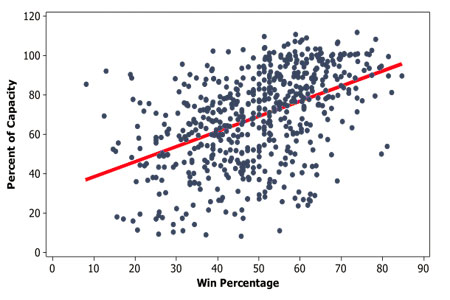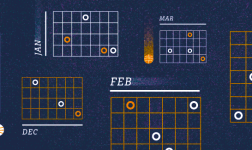By Michael Schuckers and Zach Nelson
St. Lawrence University, Statistical Sports Consulting, LLC
During the 2007-2008 season, the Air Force Falcons men’s hockey team won just over 60% of its games, and attendance at Cadet Ice Arena averaged about 66% of capacity. The following year, the Falcons won 71% of their games, and attendance exceeded 100% of capacity. Air Force’s results over those two seasons are not typical but do exhibit the basic trend we found in analyzing the impact of winning on attendance: winning is the primary driver of higher attendance.
To assess the factors that contribute to the percent a rink’s capacity is filled each season, we analyzed NCAA Division I men’s hockey data from the 2002-2003 through 2011-2012 seasons. In total, we analyzed more than 500 team-years’ worth of data. Our focus was on measurable variables and factors that influenced each team’s attendance. Because of market differences among teams, we focused on percent of capacity (Cap%) as our outcome. For example, capacity at Wisconsin’s Kohl Center is 15,325 seats, while capacity at St. Lawrence University’s Appleton Arena is 3,000 seats.
Fig. 1 — Impact of Winning Percentage on Percent of Capacity

Average capacity per year per team was approximately 68% with a standard deviation of 23.9%, suggesting there is a good deal of variability in Cap% filled by teams. Our focus was on factors that impact attendance as measured through Cap%.
Similarly, our focus for team metrics of performance was on average performance per game. Among the performance metrics we included were average goals for (GFA), average goals against (GAA), winning percentage (Win%), winning percentage in conference (Win%Conf), power play percentage (PP%), power kill percentage (PK%), and average penalty minutes (PMA). We found that there were significant correlations between each of these performance measures and Cap%. However, the correlation between Win% and Cap% was stronger than the other correlations [fig. 1]. Win% was the biggest driver of attendance. Our conclusion is that these other factors impact Cap% indirectly through their impact on Win%. On average, after adjusting for team effects, we found that for each change in a team’s Win% of 10%, we expect Cap% will increase by 18% [fig. 1]. That is, for a team that goes from a 60% Win% to a 70% Win%, we expect average attendance will increase by about 18% of capacity.
Winning draws fans consistently in rinks across the country.
Additionally, we found that Cap% was closely correlated with goal differential. This is not surprising since goal differential and Win% are very highly correlated. [In other work that we have done, we have found a similarly strong relationship between winning percentages and goal differentials for National Hockey League teams.] In a further analysis of these data, we looked at the impact of GFA and GAA among these NCAA teams and found the impact on winning was the same for both scoring goals and giving up goals. That is, offense and defense had equal weight in determining a team’s Win%. This suggests a team gains just as much, in terms of Win%, by being good offensively (i.e., scoring more goals) as it does by being good defensively (i.e., giving up fewer goals). Consequently, there is no definitive way to build a winning team.
Winning teams aren’t just those that are good at scoring goals, nor are winning teams only those that allow very few goals. Winning teams are those that consistently outscore their opponents any way they can.
Do that, and the fans will follow.




